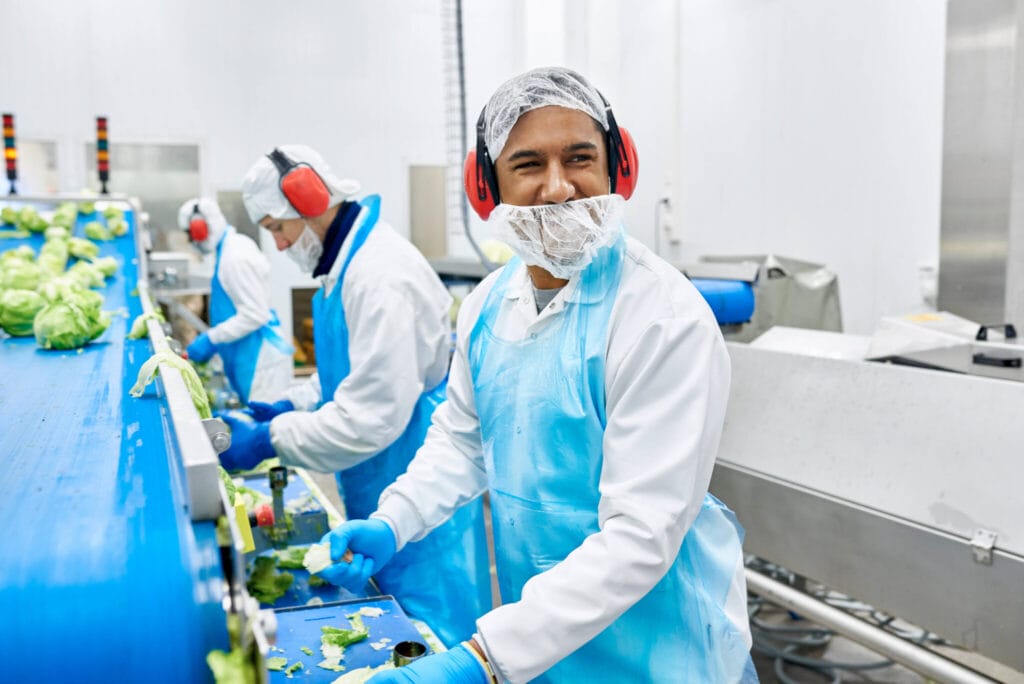
Understanding FSSAI: ensuring safe workwear in food
Working across food plants in India, whether in dairy, snacks, or export ready units, we all know the importance of food safety (as described in FSSAI). Hygiene in food is only as strong as the weakest link. In many cases, this link is workwear and staff behaviour when it comes to personal hygiene.
Most food professionals are well familiar with the Food Safety and Standards Authority of India (FSSAI). Established under the 2006 Act, it’s evolved through 2011 regulations, 2020 amendments, and now the 2023 draft rules are setting the tone for 2025. The message is clear: food safety is more than ingredients or surfaces. It’s also about what your team wears on the production floor.
In this article, we introduce the key points to you working in the roles of QA leads, plant heads, and operations managers. You navigate these changes in real time, and Lindström as a workwear partner is looking to support you.
Licensing & registration essentials
Getting your FSSAI license right is non-negotiable. Whether you’re a central-licensed large processor or a state-level unit, your license is your lifeline.
The e-FLRS portal makes the process manageable, but don’t fall into the trap of letting expiry dates slip by, and keep soft and hard copies available at hand. Consider license management as the first checkpoint in your FSSAI audit trail.
Schedule 4: General hygiene requirements
Schedule 4 is where it gets interesting. It’s the part of the regulation that covers hygiene in real operational terms.
For large manufacturers, Part IV is the one to watch. SOPs around pest control, equipment hygiene, and yes—staff workwear—are front and centre.
The main advice for large team management is to avoid cutting corners on employee uniforms. Poor garments can carry lint fibres, harbour bacteria, or can’t be traced after laundry. In addition to subpar laundry practices, these are serious risks to your compliance.
Critical control points: where non-compliance hides
Often, common compliance breaches happen where no one’s looking. Such as:
- Labels and packaging: Outdated labels can lead to non-compliance. What processes do you used to avoid it?
- Allergen protocols: A spoon used in the wrong section?
- Water quality: Still using a local borewell without monthly testing?
- Workwear: Non-detachable buttons, faded logos, or inconsistent cleaning cycles? Major red flag.
The workwear angle most audits miss
Uniform hygiene often goes under the radar until it triggers a serious non-compliance issue. Yet FSSAI’s Schedule 4, Clauses 10 and 11, are very clear: cleanliness and hygiene of are mandatory. This also includes their use of workwear.
Garments with frayed edges, loose trims, or inconsistent cleaning cycles can lead to contamination. In high-risk areas, uniforms must be changed daily and maintained in visibly
clean condition.
Facilities still managing uniforms in-house should consider the following:
- Are microbial kill rates during washing being validated?
- Are garment repair and replacement logs maintained?
- Can the team trace each uniform batch post-laundry?
Having processes in place for these things help you stay prepared for audits, and keeps your production lines compliant.
Outsourcing workwear to experts for compliance
Outsourcing uniform management to a specialised provider, such as Lindström, is becoming a preferred choice for many food manufacturers. The reasons are practical and directly tied to compliance:
- Laundry processes follow EN 14065 standards to ensure hygienic safety.
- RFID tracking provides complete garment traceability, helping prevent mix-ups or losses.
- Proactive maintenance and automatic replacements reduce the risk of uniform failures on the production floor.
A professional rental system brings consistency, reduces administrative burden, and helps ensure compliance is maintained at all times.
Documentation & record-keeping cheat sheet
Strong documentation is one of the most effective tools for audit preparation. Whether digital or physical, records must be organised, up-to-date, and easy to access. Key documents to maintain include:
- Valid FSSAI license copies and renewal records
- Batch processing and cleaning logs
- Workwear hygiene certificates from laundry providers
- Pest control reports
- Staff hygiene and compliance training records
With these in place you can stay confident in continued operations, even with a surprise audit.
Penalties, recalls and reputational risk
Compliance failures, for instance product recalls due to lint contamination or expired licenses can lead to substantial financial penalties and reputational damage. Even a single incident can wipe out years of trust.
Food businesses should regularly review recall cases in their segment and understand the current fine brackets under FSSAI 2023 and the upcoming 2025 updates. Proactive measures now can prevent far greater losses later.
Action Plan: 30-Day FSSAI Compliance Sprint
For operations looking to boost FSSAI readiness quickly, the following checklist can provide a practical framework:
- Schedule internal audits to simulate FSSAI inspections.
- Review and update all SOPs to match the latest FSSAI draft guidelines.
- Inspect current uniforms for hygiene, labelling, and durability.
- Train production staff on updated hygiene, allergen, and uniform protocols.
- Implement or validate RFID tracking for garment traceability.
FAQs for FSSAI
Here are some common questions auditors may ask during inspections:
- How often must licenses be renewed? Typically every 1-5 years, depending on the license type.
- What are the specifications for uniforms? Uniforms must meet FSSAI hygiene guidelines, focusing on material and cleanliness.
- What are the microbial limits for workwear? Specific limits are outlined in FSSAI’s hygiene standards.
- Are third-party audits necessary? While not mandatory, they can enhance compliance assurance.
- What are the penalties for non-compliance? Penalties range from fines to shutdowns, depending on the severity of the violation.
Additional questions often asked about FSSAI
The Food Safety and Standards Authority of India (FSSAI) is responsible for setting standards and regulating the manufacturing, storage, distribution, sale, and import of food products to ensure safe and wholesome food for human consumption.
The Food Safety and Standards Authority of India (FSSAI) is responsible for setting standards and regulating the manufacturing, storage, distribution, sale, and import of food products to ensure safe and wholesome food for human consumption.
Companies can refer to the official FSSAI website, attend workshops and seminars, and consult with compliance experts to gain a deeper understanding of FSSAI guidelines and updates.
Hygienic workwear is crucial to prevent contamination in food processing environments. Proper workwear helps maintain cleanliness and complies with the standards set to ensure food safety.
Companies should keep all relevant documentation updated, conduct regular training for staff on compliance protocols, and perform routine checks to ensure all practices meet FSSAI standards. This proactive approach can help in smooth audits.
Yes, non-compliance with FSSAI regulations can impact a company’s reputation and credibility, potentially affecting international trade opportunities, as global partners often require adherence to local and international safety standards.
Rental programs can help by providing hygienically laundered workwear, ensuring traceability with RFID technology, and offering regular maintenance and replacement services to prevent garment failures.




